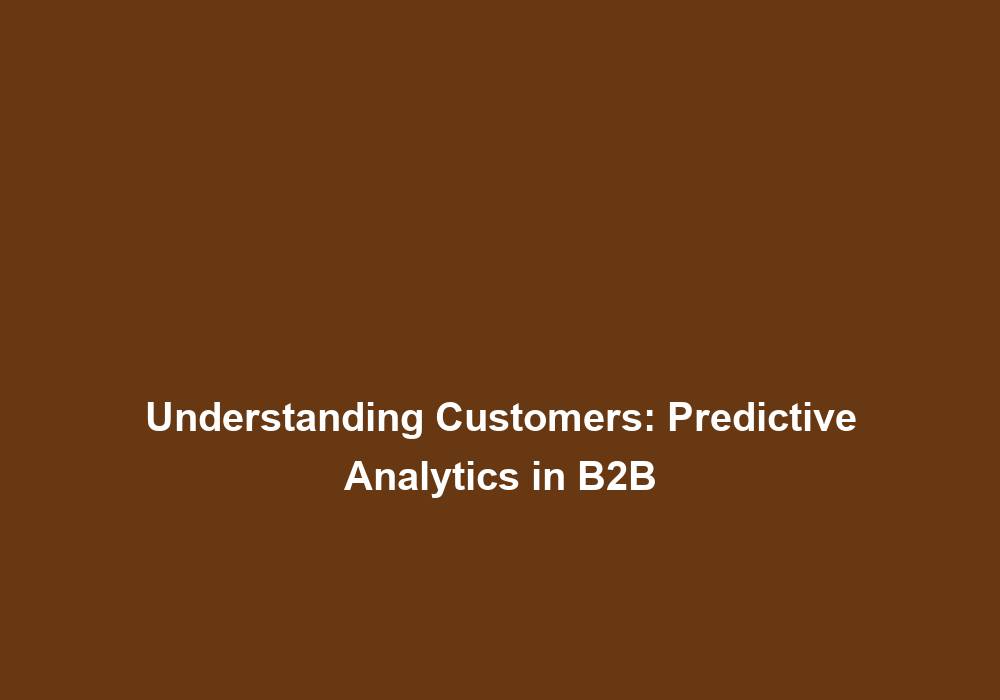In the rapidly evolving world of business-to-business (B2B) sales and marketing, understanding customers and their behavior is crucial for success. Predictive analytics has emerged as a powerful tool that enables B2B companies to gain deep insights into customer preferences, needs, and future actions. In this article, we will explore the concept of predictive analytics in the B2B context, its benefits, and how it can be effectively utilized to drive growth and profitability.
What is Predictive Analytics?
Predictive analytics is an advanced data analysis technique that leverages historical data, statistical algorithms, and machine learning models to make predictions about future outcomes. It goes beyond traditional descriptive and diagnostic analytics, which focus on understanding what happened and why. With predictive analytics, B2B companies can anticipate customer behavior and make data-driven decisions to optimize their marketing and sales strategies.
Predictive analytics enables B2B companies to gain a comprehensive understanding of their customers’ behavior. By analyzing patterns and trends in historical data, such as purchase history, website interactions, and social media engagement, businesses can identify key indicators of customer preferences and needs. This information allows companies to tailor their products, services, and marketing efforts to meet the specific needs of their target audience.
In addition to understanding customer behavior, predictive analytics also helps B2B companies identify potential sales opportunities. By analyzing various data sources, such as CRM data, demographic information, and market trends, businesses can identify prospects who are most likely to convert into paying customers. This allows sales teams to focus their efforts on high-potential leads, increasing efficiency and conversion rates. By leveraging predictive analytics, B2B companies can prioritize their sales efforts and allocate resources effectively.
Furthermore, predictive analytics can be used to enhance customer retention efforts. By analyzing customer data, such as feedback, complaints, and usage patterns, businesses can identify early warning signs of customer dissatisfaction or churn. This enables proactive intervention, such as personalized offers or proactive customer service, to prevent customer attrition and strengthen long-term relationships. By identifying and addressing customer concerns in a timely manner, B2B companies can improve customer satisfaction and loyalty.
Another key benefit of predictive analytics is its ability to optimize marketing campaigns. By analyzing historical campaign data, customer segmentation, and market trends, businesses can identify the most relevant target audience, select the best channels, and tailor messages that resonate with potential customers. This improves campaign ROI and overall marketing performance. By leveraging predictive analytics, B2B companies can make informed decisions about their marketing strategies and allocate resources effectively.
Additionally, predictive analytics assists B2B companies in accurate sales and revenue forecasting. By analyzing past sales data, market trends, and external factors, businesses can generate predictive models that estimate future sales volumes and revenue. This enables proactive planning, resource allocation, and budgeting, helping businesses achieve their financial targets more effectively. By leveraging predictive analytics, B2B companies can make data-driven decisions and optimize their sales strategies for maximum profitability.
To effectively leverage predictive analytics in the B2B context, businesses should consider the following best practices:
-
Define Clear Objectives: Clearly define the objectives and goals you seek to achieve through predictive analytics. Whether it is improving customer retention, increasing sales, or optimizing marketing efforts, having well-defined objectives helps in aligning data analysis and decision-making processes.
-
Collect and Consolidate Relevant Data: Identify and collect relevant data from various sources, such as CRM systems, website analytics, social media platforms, and customer feedback. Ensure data accuracy, cleanliness, and compatibility across different sources to derive meaningful insights.
-
Employ Advanced Analytics Tools: Utilize advanced analytics tools and platforms that offer predictive modeling capabilities. These tools can automate data analysis, perform complex calculations, and generate predictive models that can be integrated into existing systems or used as standalone solutions.
-
Invest in Data Science Capabilities: Consider investing in data science expertise or partnering with external experts to maximize the value derived from predictive analytics. Data scientists can help in building and fine-tuning predictive models, interpreting insights, and driving data-driven decision-making across the organization.
-
Continuously Refine and Improve: Predictive analytics is an iterative process that requires continuous refinement and improvement. Regularly evaluate and update your predictive models based on new data, changing market conditions, and evolving customer behavior to ensure accuracy and relevance.
In conclusion, predictive analytics has revolutionized the way B2B companies understand and engage with their customers. By leveraging historical data and advanced statistical techniques, businesses can gain valuable insights into customer behavior, optimize marketing efforts, identify sales opportunities, and enhance customer retention. However, it is essential to follow best practices, invest in appropriate tools, and continuously refine strategies to reap the full benefits of predictive analytics in the B2B landscape. Embracing predictive analytics as a strategic tool can propel B2B companies towards sustainable growth, profitability, and a competitive edge in today’s dynamic business environment.

I found your insights on predictive analytics in B2B sales and marketing really engaging. It’s fascinating how something seemingly complex can offer such practical solutions for businesses looking to understand their customer base better. I’ve seen first-hand how using data-driven strategies can transform the sales process.
It’s great to hear you found the insights on predictive analytics engaging. You’re right—what often seems complex can lead to real, actionable strategies. I’ve also seen how businesses that leverage data can not only refine their approach but also foster deeper relationships with their customers.